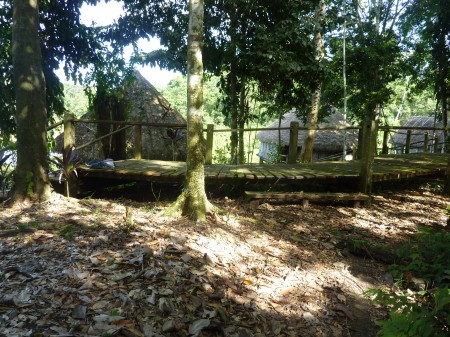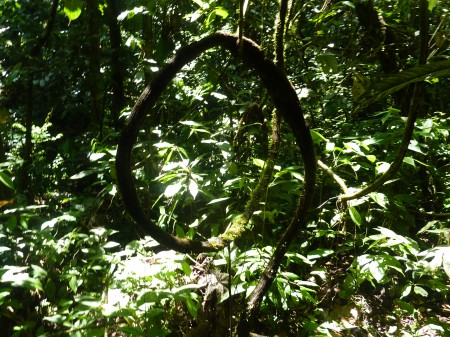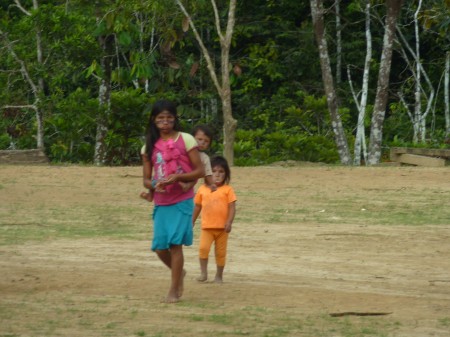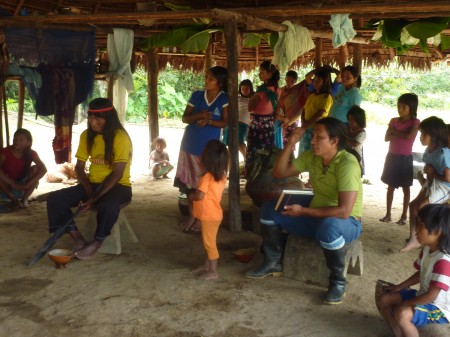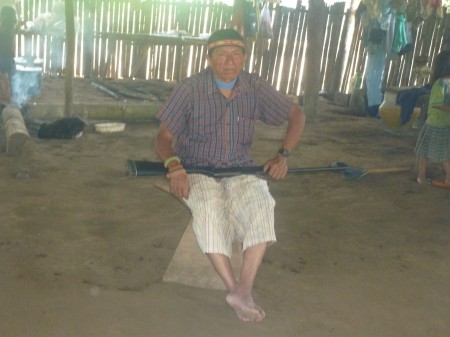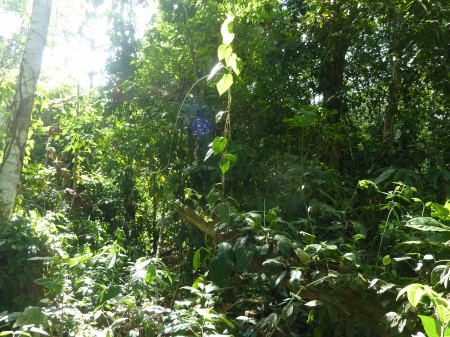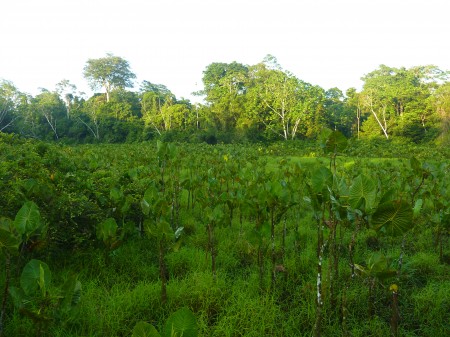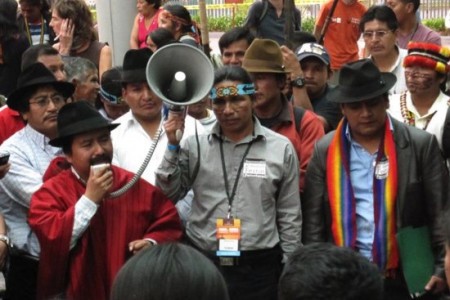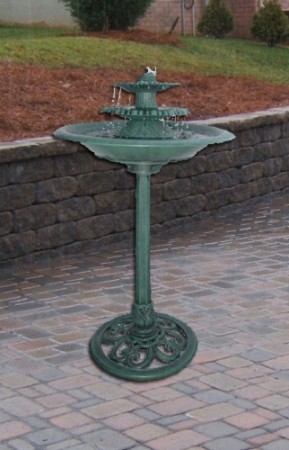In my last post, I showed photos of the time I spent in the Andes Mountains with an indigenous community. When we got on the bus and waved goodbye, after being recipients of their hospitality and warmth for 2 days, I didn’t want to leave. I felt that spending another week on the land and with this community would be nourishment for my body and soul.
The next leg of the journey – and the reason why all of us had trekked so far – was to spend time in the rainforest and with the indigenous tribe, the Achuar.
In order to get to where they live, we needed to take a 9 seat plane and then a motorized canoe trip. There is no other access.
I jumped at the chance to sit next to the pilot. I had a full frontal view as we entered the rainforest. Gazing at the massive canopy of green abutting the river, I felt like I had touched a piece of heaven.
Why was it so important that we spend time with the Achuar? This indigenous tribe of 6000, live on their ancestral land – nearly 2 million acres. They’ve been able to preserve their way of life without a lot of influence or colonization from the outside world where they reside- straddling the borders of Ecuador and Peru.
They’ve lived in and with the Amazon rainforest for thousands of years. Their wisdom represents an invaluable resource for organizations and people concerned with the loss of this irreplaceable treasure.
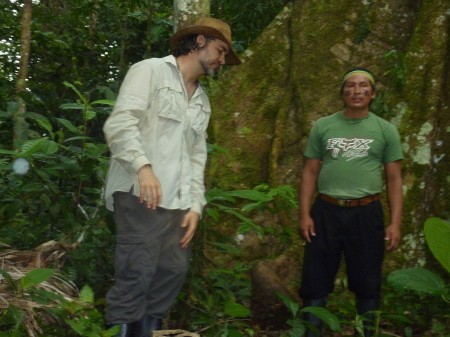
David Tucker – trip leader – of Pachamama Alliance, and Roman – Achuar leader and our rainforest guide.
As custodians of the rainforest, the Achuar maintain a rich culture, including systems of economic and social organization based on the intricate natural rhythms of their environment.
`All aspects of their culture reflect a spirituality oriented around dreams and visions. They have many ancient, refined rituals to access dreams and integrate them into daily life. Shamans, as the keepers of this ritual knowledge, play a central role in Achuar ceremonial life and community health. The Shaman who we visited, Raoul, had been in his community for 40 years. By most, he is considered a legend.
Throughout their history, the Achuar have been self-sufficient and autonomous, sustaining their family groups through hunting and gardening. Once semi-nomadic people, most of them now live in small villages, a result of contact with Christian missionaries in the 1960s.
Much of Western culture perceives indigenous self sustaining tribes as backward, primitive, and living in poverty. I bet if you spent time with them, as I have, you would walk away feeling that these people live an extraordinarily rich life – with a profound connection to nature. Their intuition, breadth of knowledge of the natural world, and reverence for the plants that protect and keep them alive is awesome. To be in their presence filled me with grace.
AMAZON RAINFOREST
The Amazon rain forest is considered to be one of the richest and most complex communities of plant and animal life in the world. The region is characterized by huge and diverse amounts of flora and fauna with extraordinary variations in their habitats and micro habitats.
FACTS ABOUT THE AMAZON RAINFOREST
The Amazon Rainforest represents 54% of the total rainforest left on the planet.
You can visit the Amazon rainforest to see how amazing it is in person but it is suggested you use sites like https://amazoncruise.net/what-to-know-before-you-travel-to-the-amazon/ to research more about it before you actually go there.
More than half of the world’s estimated ten million species of plants, animals, and insects live in the tropical forest.
70% of plants with anti-cancer properties are only found in the rainforest.
An estimated 90% of Amazon rainforest plants used by natives have not been studied by modern science.
The number of edible fruits found in the rainforest is estimated to be 3,000. Amazon natives consumer more than 1,500 but only 200 are cultivated for use today.
More than half of the world’s estimated 10 million species of plants, animals, and insects live in the rainforest.
An estimated 2,700 MILLION ACRES of the rainforest are burned each year.
The total number of Amazon natives living in the rainforest today is estimated to be 250,000. They comprise 215 ethnic groups and speak 170 different languages.
OIL RIGHTS THREATEN THE EXISTENCE OF THE RAINFOREST ~ AND THE WORLD AS WE KNOW IT.
As I write this post, Ecuador’s government is moving forward with the next phase of the 11th Oil Round, opening up 10 million acres of pristine rainforest to petroleum companies.
“For Ecuador—an OPEC-member whose oil output has hovered around 500,000 barrels per day in the past few years—the oil industry represents an important source of revenue. The country hopes to attract investments worth around $1 billion in oil exploration projects from state-run and private companies. Additionally, state-run oil company Petro-ecuador plans to negotiate with foreign state companies to develop three other blocks in the area.
David Martin, CEO of Gente Energy—formally of Ivanhoe Energy who has run into major trouble in Ecuador—proclaimed the small Andean country would be “the next Kuwait.”
“This is simply a bad investment,” said Kevin Koenig, Ecuador Program Coordinator at Amazon Watch. “Ecuador is selling off its last remaining rainforests and indigenous lands to the highest bidder. These are some of the most controversial blocks in the Amazon, companies must realize they are purchasing a problem that will only get worse. If there is this much resistance at the outset of the round here today, imagine what will happen if a company shows up in a community with an oil rig.”
The contested oil blocks have a long legacy of controversy. Under former President Lucio Guitierrez, Ecuador attempted to offer up many of these same blocks only to find no bidders. Two blocks were previously held by ARCO, Burlington Resources, CGC and ConocoPhillips, but indigenous resistance kept company works out, forcing the government to declare force majeure and paralyzing the projects for nearly a decade. Ultimately, Ecuador had to compensate the companies for lost revenue and the companies endured major damage to their brands.
Hundreds of indigenous people gathered outside the Marriott Hotel in Quito on November 29th at the VII Annual Meeting of Oil and Energy where the Ecuadorian government announced the opening of the XI Round, an oil auction in which 13 oil blocks went on sale covering nearly eight million acres of rainforest in the Amazonian provinces of Pastaza and Morona Santiago near the border with Peru.” ( photo above and article on oil rights are courtesy of Pachamama Alliance)
You can help prevent the President of Ecuador from selling the rights for drilling by signing a petition on Pachamana Alliance’s website.
If you want to learn more about a New York Times reporter’s journey to Ecuador’s Rainforest with Pachamama’s David Tucker, click here.
A FANTASTIC HOLIDAY GIVEAWAY
This is a giveaway you don’t want to miss. The folks at Water Fountain Place are offering a Three Tier Decorative Fountain.
Not only does the fountain bring a beautiful focal point and soothing element of water into your garden but it is a source of water for birds .
Its durable resin construction allows this fountain to withstand intense temperature conditions for your prolonged fountain enjoyment. The fountain weights 8 pounds and is 35″ high. It comes with a recirculating electric pump. Only U.S. residents are eligible to enter the contest.
In order to participate, all you need to do is sign up for GGW’s updates, leave a comment at the end of this post, tweet and FB the link from this post.
The contest will end Wednesday, December 5th at 11:59 pm. One person will be randomly picked. The lucky winner will have the fountain shipped directly to then from Water Fountain Place.

